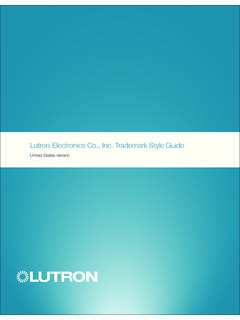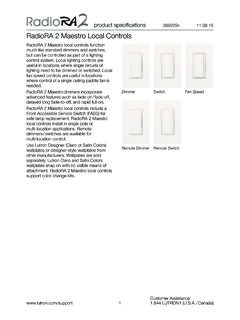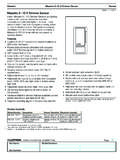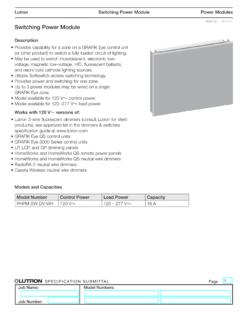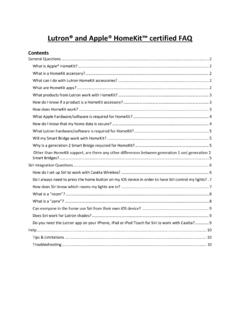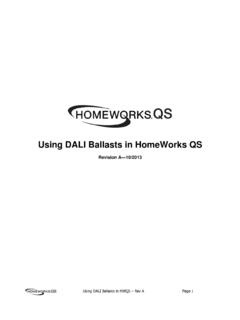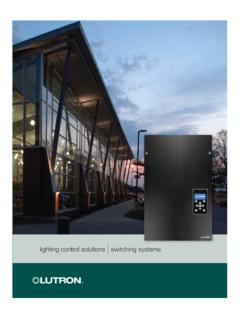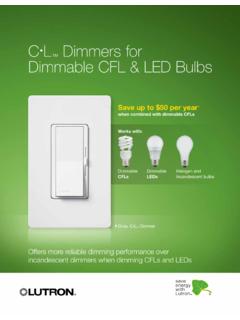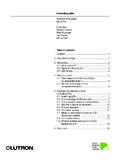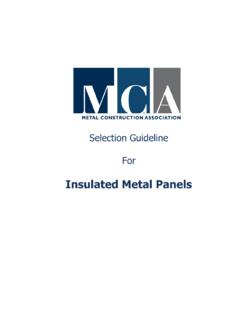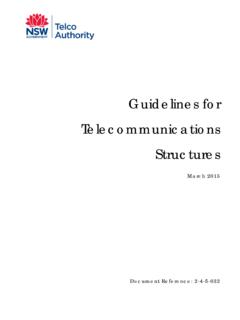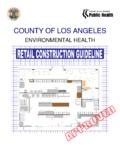Transcription of RadioRA 2 and HomeWorks QS Networking Guide App …
1 RadioRA 2 and HomeWorks QS Networking GuideApplication Note #731 Revision BMarch 20211 Customer Assistance document will act as a Guide for establishing communication with a RadioRA 2 or HomeWorks QS system and will describe various ways to overcome the network and computer challenges that you may encounter. Table of Glossary and Abbreviations .. Network and IT Considerations .. Communication Port Diagram .. Connecting to the RadioRA 2 Main Repeater .. Important Notes when Connecting to a Two Main Repeater System .. Connecting to the Lutron Connect Bridge ( RadioRA 2) .. Connecting to HomeWorks QS Processors .. Network Hops with HomeWorks QS Processors .. Connecting to the Lutron Connect Bridge ( HomeWorks QS).. Best Practices .. Firewalls and Security Programs.
2 Check Inbound Firewall Rules .. Allow Lutron Programs through the Firewall .. Using a Work or Home Network Connection to the System .. Force TCP Software-to-Processor Communication .. Changing to TCP Communication in HomeWorks QS .. Changing to TCP Communication in RadioRA 2 .. Disable Firewall Temporarily .. Using Wi-Fi with Lutron Programming Software .. Running Windows OS on Mac .. Parallels and VMware Fusion .. Multiple Network Adaptors .. VPN Connections .. Internet Group Management Protocol (IGMP) .. How do switches route multicast traffic? .. What is IGMP Snooping? .. IGMP Snooping and Lutron Residential Systems .. Connect Bridge and Lutron Residential Systems .. Appendix HWQS System on Network with Snooping Disabled .. Appendix HWQS System on Network with Snooping Enabled.
3 Setting Static IP Addresses .. General Static IP Best Practices .. DHCP Reservation vs. Setting Static IP in the Programming Software .. Setting a Static IP Address in Windows .. Troubleshooting .. RadioRA 2 Find Main Repeater/Connect Bridge Error Codes .. HomeWorks QS Activate Processors/Connect Bridge Error Codes .. Using a Direct Connection to a Lutron Processor .. Direct Connection using Static IP Address .. Direct Connection using Link Local Addressing .. Frequently Asked Questions .. Note # Glossary and AbbreviationsHomeWorks Processor This is the basic HomeWorks QS controller and will be the main HomeWorks component connected to any network. Each HomeWorks QS Processor has two RJ45 female connectors, one for the HomeWorks QS LAN/VLAN connection and the other for serviceability.
4 Main Repeater This is the basic RadioRA 2 controller and will be the main RadioRA 2 component connected to any network. Each RadioRA 2 Main Repeater has one RJ45 female connector for the RadioRA 2 Abbreviation of HomeWorks Abbreviation of RadioRA May refer to either/both the HomeWorks QS Processors and RadioRA 2 Main Machine Refers to the PC or laptop which is running the HomeWorks QS or RadioRA 2 software. The machine must be running a Windows Connect App Phone-based UI to monitor and control HomeWorks and RadioRA 2 systems. Available on HomeWorks and RadioRA 2 software versions and designer Client UI for setup and programming of the HomeWorks system. Primary software for all HomeWorks software The number of intermediate devices which data packets must pass between source and destination to include layer 3 and layer 2 devices within the network.
5 This includes any device that will delay the data packets from a source processor to a destination Limit A hop is one portion of the path that a packet takes from source to destination. Traditionally, the hop limit refers to the time to live (TTL) of that packet before it is discarded. With a Lutron system, the hop limit is not concerned with TTL, rather it is a guideline so that latency of the system commands is kept to a A communication method over Ethernet TCP or point-to-point Processor Processor #1 in the system. This processor takes on the role of synchronizing timeclocks in the system, as well as handling communication with the Connect A communication method over Ethernet UDP or as one-to-many communication. Lutron systems use multi-source multicast communication so that any device on Ethernet can talk to every other device on the Ethernet at the same Lutron processors supports Versions 1, 2, and 3 for multicast communication within a system.
6 Any possible flooding of multicast traffic can be constrained to a set of interested ports by using IGMP If Lutron processors within a system are deployed on different subnets and need routing, PIM is supported in both sparse and dense modes. PIM is typically not required if the connections from the commissioning machine to the processors is configured for Unicast and if all processors are on the same Telnet is an application layer protocol used to provide a bi-directional text-based communication between client and server devices. Lutron processors will use this protocol over TCP/IP for two main instances: 3 Customer Assistance Note # Network and IT ConsiderationsNetwork Architecture OverviewWhat is on the traditional network IP architecture? The HomeWorks Processors/ RadioRA 2 Main Repeaters, and client devices ( PC, laptop, tablet, etc.)
7 What is NOT on the traditional network IP architecture? The lighting actuators, sensors, and load controllers are not on the network architecture. This includes keypads, wired and wireless temperature sensors, wired and wireless occupancy sensors, thermostats, load controllers, dimmers, switches, lighting panels, fluorescent lamp ballasts, or LED drivers. These devices communicate on a Lutron proprietary wired or wireless communication network. Physical MediumIEEE Ethernet Is the physical medium standard for the network between HomeWorks Processors or RadioRA 2 Main Repeaters. Each HomeWorks Processor and RA2 Main Repeater has female RJ45 connectors for LAN The minimum network wire specification of the HomeWorks QS and RadioRA 2 AddressingIPv4 The addressing scheme used for the HomeWorks QS and RadioRA 2 systems.
8 The IPv4 address should be static but a DHCP reservation system can also be used. DNS Hostname is not supported. The IPv4 address can be field set to any range, Class A, B, or C. Static will be D addressingHomeWorks QS/ RadioRA 2 System A system is a multicast group of HomeWorks Processors or RA2 Main Repeaters sharing a unique and common class D address that need to share events. Maximum 16 HomeWorks QS Processors on a HomeWorks QS system or two RadioRA 2 Main Repeaters on a RadioRA 2 system. Minimum one HomeWorks QS Processor on a HomeWorks QS system or one RadioRA 2 Main Repeater on a RadioRA 2 communications Basic communication to share events between HomeWorks Processors or RadioRA 2 Main Repeaters is based on UDP multicast groups. Below are details on how the Lutron systems deploy this communication scheme.
9 All Lutron processors share events and will need a unique and common class D address. The class D multicast address can be field set and specified by the customer. Any source multicast is used because any Lutron processor may be enacting the event. Multicast communication in Lutron systems is primarily event based ( , system trigger or change in state for monitoring). Polling is not a basis of communications in Lutron systems. Prior to software version , the HomeWorks QS commissioning laptop/PC needed to join every multicast group to communicate to the HomeWorks Processors. Commissioning machines hosting software version and newer can either communicate to the HomeWorks Processors by joining every multicast group or can be setup as TCP unicast communication. This can be setup during system startup at the customer s discretion.
10 For RadioRA 2, this functionality was introduced in software version : Multicast communication is still required for communication among the processors in a system. Setting up the commissioning laptop to talk to a Lutron system using TCP communication only changes processor discovery and transfers to TCP communication. Note # Network and IT Considerations (continued)Ports (REQUIRED)Processor to Processor within a HomeWorks QS or RadioRA 2 system UDP/2056 Commissioning Machine to Processors UNICAST OPTION TCP/51023 TCP available only for commissioning machine hosting HomeWorks software version and newer, or RadioRA 2 software version and newerCommissioning Machine to Processors MULTICAST OPTION UDP/2056 Upgrading of Processors TFTP/69, UDP/777 Note: Unicast or multicast communication option is configured on site by a Lutron qualified dealer and at the customers determination.
